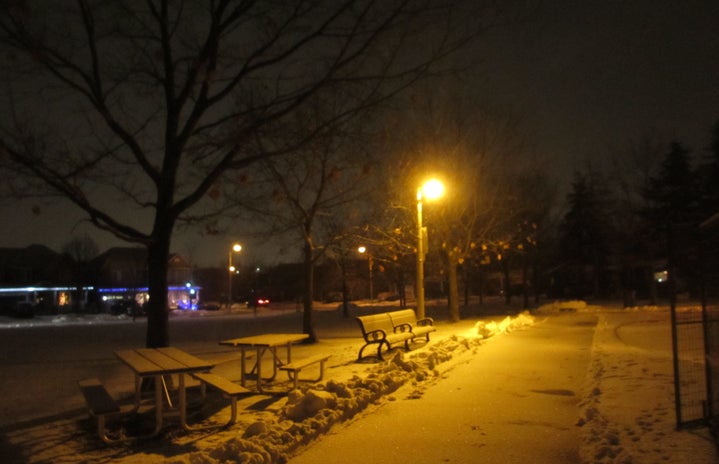It’s officially the time of year when social media users begin to post jokes about “seasonal depression,” the feeling of not wanting the weather to get colder and the days to become shorter. However, a darker reality hides behind this trendy expression, and many students, especially international ones, unfortunately experience it.
As a 17-year-old freshly out of high school and on my way toward the “great Canadian dream,” I felt unstoppable.
As the plane touched down in Toronto in late August 2021, I couldn’t help but feel a sense of excitement tinged with a little bit of fear — though I mostly blamed the latter on my own nerves. I had heard tales of the freezing Canadian winters, but nothing could’ve prepared me for the biting cold and the movie-like blanket of snow that would come to define my first winter.
The transition from the small, cozy town of Reims, France, to the bustling city of Toronto was a culture shock in itself. As the autumn leaves fell and the temperatures quickly plunged, I found myself confronted with a new challenge that I had underestimated. It wasn’t long before I began to feel the winter blues, or as I later learned, Seasonal Affective Disorder — ironically SAD for short.
The first snowfall was nothing short of a mesmerizing experience; watching the world turn white was something I had only seen in movies. Yet, as the days grew shorter and the skies became greyer, I found myself succumbing to the gloomy grip of SAD that wouldn’t leave my side. Suddenly, I was overwhelmed by the simplest of tasks and unable to do anything but sulk in my dorm room all day. The unfamiliarity of the city, combined with the limited daylight hours, was taking a toll on my mental health, and it was getting worse by the second.
According to Mayo Clinic, one of the causes of SAD is the disruption of your body’s biological clock due to decreased sunlight. In Canada, the sun seemed to hide behind thick clouds for days on end, leaving me more isolated and hopeless. In Toronto, my life had become a race against the clock as I tried to make the most of the limited daylight. However, it seemed like I was doomed to lose this race time and time again.
My initial reaction was naturally to cocoon myself in my dorm room, waiting for it to pass, like a cub hibernating in hopes of warmer days. It soon became clear that isolation was not the answer, and if I wanted to get myself out of this rut, I needed to take action.
My first instinct was to seek out warmth from other people. I tried staying longer after class talking to my peers, and with the help of clubs and study sessions, I slowly started making friends in this new, scary country. I found that my cup of coffee was suddenly warmer with someone to share it with, and my days were a little less gloomy.
However, this was just the beginning.
Mayo Clinic also lists fluctuations in appetite habits as a sign of SAD. For me, that was often characterized by cravings for comfort food. After weeks of surviving off of take-out Chinese food and eating ice cream pints while binging Gilmore Girls, I finally built up the courage to shrug on my heavy winter jacket and go out to a new location. I went to the St Lawrence Market, home to all sorts of local and delicious foods. Trying out different Canadian winter dishes, like turkey and butter tarts, became a delightful distraction, connecting me with the local culture and cuisine.
However, the most impactful change came when I decided to be more proactive about the lack of sunlight I was suffering from. The answer turned out to be simple: light therapy in the form of a simple lightbox designed to simulate natural sunlight, which soon became my valuable companion. Slowly, I started noticing a significant improvement in my mood and energy levels. I also learned to appreciate the beauty of frosty mornings because sometimes, all you need is an extra 10 minutes of sunlight a day in the comfort of your own bed.
As an international student, homesickness also played a huge role in my battle against the winter blues. This proved to be a harder challenge to overcome, but it was nothing a call to my mom couldn’t fix. After a quick, comforting talk and a few Google searches, she found a WhatsApp group of fellow expats looking to connect. I instantly felt better after a few ice-skating outings where I could speak my dearly missed French language.
Overall, my journey from France to Canada was a huge change marked by many challenges. Once May hit, I had not only survived my first Canadian winter but had gotten better about dealing with the winter blues that came with it. I discovered that with the right strategies and a positive mindset, the harsh winter months could become a period of growth and self-discovery instead of weeks of sulking and watching your favourite comfort show.
While this monumental life transition took its toll on my mental health, it also opened doors to experiences and friendships that I wouldn’t trade for anything in the world today. I have finally come to embrace the snowy landscapes and the cozy winter nights the Canadian winter offers. In overcoming SAD, I have not only adapted to a new environment but have also learned valuable lessons about resilience, self-care and, above all, reaching out for help when you most need it.
While all of this will not stop me from huffing and puffing my way through the never-ending Canadian winter this year, these small changes I have discovered along the way will hopefully serve a larger community of international students looking for a way to find a home in their new life chapter.


